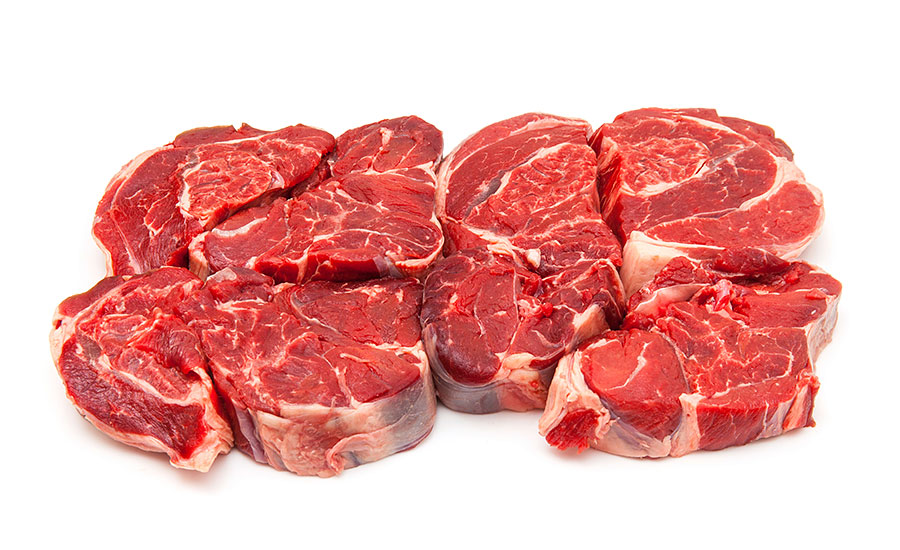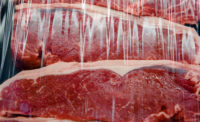Higher Education | Steak Discoloration
Novel probe-type oxygen sensor to measure oxygen consumption in beef steaks

According to the Food and Agriculture Organization, about one-third of food produced for human consumption worldwide is wasted, and of that, over 20% is meat (FAO, 2012). A large portion of the discarded beef is due to its discoloration. Consumers prefer a bright-cherry red appearance, and any deviation can lead to a decrease in purchase (Carpenter, Cornforth, & Whittier, 2001). Myoglobin (Mb) is the color pigment in the meat, and oxygen (O2) binding to Mb leads to bloom and a bright-cherry red color, called Oxymyoglobin (OMb). However, muscle specificity leads to variances in color stability and shelf life, leading to the formation of metmyoglobin (MMb), a brown-pigment.
Oxygen consumption (OC) is an inherent muscle property that influences beef color. More specifically, greater OC results in less bloom and darker meat color, while lower OC can promote a bright-red color. Mitochondrial function, microorganisms, and oxidative processes can influence oxygen utilization. Hence, the quantification of OC is important to characterize beef color changes. The OC measured using reflectance indirectly assesses oxygen utilization based on changes in myoglobin redox forms. Here, we discuss a novel fiber optics oxygen probe to measure changes in the percent partial pressure of oxygen on the surface of beef longissimus lumborum steaks. The objective of the current study was to compare OC using a near-infrared (NIR)-based oxygen sensor, fiber optics oxygen probe, and reflectance approach.
Steaks from four beef Choice striploins were used in the study (n = 4; postmortem age > 7 days).
The OC quantification using the reflectance approach was based on the American Meat Science Association Meat Color Measurement Guidelines. In brief, steaks were bloomed for 60 min and then vacuum packaged and incubated at 30°C for 30 minutes inducing conversion of oxymyoglobin to deoxymyoglobin. The color changes were measured using a HunterLab MiniScan spectrophotometer, oxymyoglobin level was calculated as [1 – (K/S610 ÷ K/S525)]. K/S represents the absorption and scattering coefficient determined at 610 and 525 nm. For NIR-based approach, the methodology used for reflectance OC was followed, and a Peripedal MOXY-3 Muscle Oxygen Monitor, was used to measure the amount of oxygen on bloomed and deoxygenated muscle. Thirdly, an Ocean Optics Neo Fox Oxygen Sensing System probe was utilized to measure the percent surface oxygen of steaks. Steaks were bloomed for 60 minuntes and then packaged in plastic bags, flushed and filled with nitrogen gas then incubated at 30°C for 30 minutes allowing for conversion to deoxymyoglobin. Percent oxygen levels were measured using the probe after a 60-minute bloom period and after 30-minute incubation period. Both NIR- and fiber optics oxygen probe gave oxymyoglobin/oxygen partial pressure in percentage. However, the reflectance approach determined oxymyoglobin levels in K/S ratios. Therefore, the percentage of oxygen consumption was measured by the differences between pre- and post- percent muscle oxygen divided by pre-incubation value x 100. The assays were replicated four times, and data were analyzed using the Univariate Procedure of SAS.
Table 1: Percent oxygen consumption of beef longissimus steak determined by three methods.
| Method | Percentage OC | Standard Deviation | Variance |
| Oxygen Probe | 85.70 | 6.3 | 2.5 |
| NIR MOXY | 12.90 | 6.2 | 40.1 |
| Hunter Lab | 7.30 | 2.9 | 8.7 |
As seen in Table 1, the results suggest the fiber optics oxygen probe was very sensitive to OC (85.7%, standard deviation =
6.3, and variance = 2.5) and detected a higher percentage of oxygen with the lowest variance level compared with NIR- and reflectance method. NIR-based MOXY detected greater levels of OC (12.9%, standard deviation = 6.2, and variance
= 40.1) with more variance than with using the HunterLab spectrophotometer (7.3%, standard deviation = 2.9, and variance = 8.7).
The Neo Fox Oxygen probe directly measures the oxygen partial pressure on the surface, hence a larger difference in oxygen level was noticed before and after incubation than indirect measurements using handheld spectrophotometers. The results suggest that the fiber optics oxygen probe-type approach is a viable method to determine the oxygen consumption of steaks.
Characterizing the biochemical basis of meat color using accurate and practical probes will help with understanding the oxidation process to limit beef wastage due to its discoloration. IP
Literature Cited:
Carpenter, C. E., Cronforth, D. P., & Whittier, D. (2001). Consumer preferences for beef color and packaging did not affet eating satisfaction. Meat Science, 57 (4), 359-363. doi: https://doi.org/10.1016/S0309-1740(00)00111-X
Save food infographics: meat food losses. Retrieved January 15, 2020, from http://www.fao.org/save-food/resources/keyfindings/infographics/meat/en/
Looking for a reprint of this article?
From high-res PDFs to custom plaques, order your copy today!








